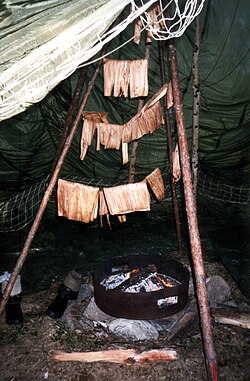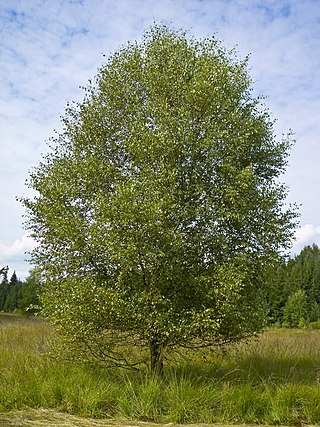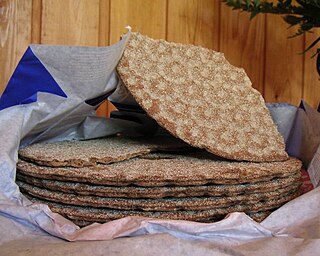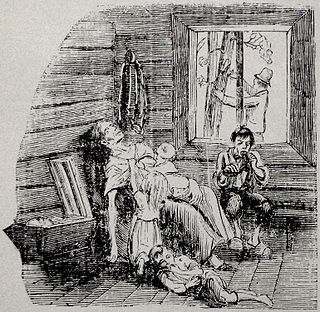 | |
| Type | Famine food, Bread |
|---|---|
| Place of origin | Scandinavia |
| Main ingredients | Flour, water, inner bark (e.g. phloem) of plants |
Bark bread is a traditional food made with cambium (phloem) flour. It has a history of use as famine food.
 | |
| Type | Famine food, Bread |
|---|---|
| Place of origin | Scandinavia |
| Main ingredients | Flour, water, inner bark (e.g. phloem) of plants |
Bark bread is a traditional food made with cambium (phloem) flour. It has a history of use as famine food.
Bark bread seems to be a primarily Scandinavian tradition. [1] Bark bread is mentioned in medieval literature, and it may have an even older tradition among the Sami people, with the oldest findings of bark harvests being around 3000 years old. [2] [3]
During the 18th and early 19th centuries, Northern Europe experienced several very bad years of crop failure, particularly during the Little Ice Age of the mid-18th century. The grain harvest was badly affected, and creative solutions to make the flour last longer were introduced. In 1742, samples of "emergency bread" were sent from Kristiansand, Norway, to the Royal Administration in Copenhagen, including bark bread, bread made from grainless husks and bread made from burned bones. [4] During the Napoleonic Wars, moss and lichen were used for human consumption. [5]
The last time bark bread was used as famine food in Norway was during the Napoleonic Wars. The introduction of the potato as a staple crop gave the farmers alternative crops when grain production failed, so that bark bread and moss cakes were no longer needed. [6] In Northern Sweden, traces of Sami harvest of bark from Scots pine are known from the 1890s, and, in Finland, pettuleipä (literally "pinewood-bark bread", made with cambium [phloem] flour) was eaten in Finland as an emergency food when there has been a shortage of food, especially during the Great Famine of the 1690s, [7] during the second famine of the 1860s, and, most recently, during the 1918 civil war. [3] [8]
Finger-sized twigs and branches were collected from deciduous trees and shrubs, and the bark split and the inner bark (the phloem and sometimes the vascular cambium) collected while still fresh. The yellow or green inner bark (depending on tree species) was dried over open fires, in an oven, or in the sun. A mortar or mill was used to grind the bark to a fine powder to add to the flour. The dried bark pieces could also be added directly to the grain during milling. The bread was then baked the normal way adding yeast and salt.
Bark bread did not leaven as quickly as normal bread due to bark content. The more bark to flour, the slower the leavening. Bark bread was therefore often made as a flatbread. The bark flour could also be used for porridge. [9]
The bark component was usually from deciduous trees like elm, ash, aspen, rowan or birch, but Scots pine and Iceland moss (sometimes named "bread moss" in Norwegian) are mentioned in historic sources. The inner bark is the only part of a tree trunk that is actually edible; the remaining bark and wood is made up of cellulose, which most animals, including humans, cannot digest. The dried and ground inner bark was added in proportions like 1/4th to 1/3rd "bark flour" to the remaining grain flour. Erik Pontoppidan, the bishop of Bergen, Norway in the mid-18th century, recommended using elm, as it helped the often crumbly bark bread hold together better. [10]
The bark will, however, add a rather bitter taste to the bread, and gives bread (particularly white bread) an unappetizing grey-green hue. Another problem is that the yeast cannot break down the ground bark; as a result, the bread will not leaven properly, and will be hard and not hold together well. Though bark today is sometimes added to pastries as a culinary curiosity, bark bread was considered an emergency food, and, as is common with such foods, was phased out as soon as the availability of grain improved.
The bark bread was seen as nutritionally deficient, more as "stomach filler" than as actual sustenance. Both the bishop Pontoppidan and others blamed the high mortality during the famine of the 1740s on the "unhealthy bark bread" and general lack of food. [4] [10] Among the Sami, however, the bark and bark bread made from Scots pine served as an important source of vitamin C. [3]

Matzah, matzo, or maẓẓah is an unleavened flatbread that is part of Jewish cuisine and forms an integral element of the Passover festival, during which chametz is forbidden.

Bread is a staple food prepared from a dough of flour and water, usually by baking. Throughout recorded history and around the world, it has been an important part of many cultures' diet. It is one of the oldest human-made foods, having been of significance since the dawn of agriculture, and plays an essential role in both religious rituals and secular culture.

Phloem is the living tissue in vascular plants that transports the soluble organic compounds made during photosynthesis and known as photosynthates, in particular the sugar sucrose, to the rest of the plant. This transport process is called translocation. In trees, the phloem is the innermost layer of the bark, hence the name, derived from the Ancient Greek word φλοιός (phloiós), meaning "bark". The term was introduced by Carl Nägeli in 1858.

Porridge is a food made by heating or boiling ground, crushed or chopped starchy plants, typically grain, in milk or water. It is often cooked or served with added flavourings such as sugar, honey, (dried) fruit or syrup to make a sweet cereal, or it can be mixed with spices, meat or vegetables to make a savoury dish. It is usually served hot in a bowl, depending on its consistency. Oat porridge, or oatmeal, is one of the most common types of porridge. Gruel is a thinner version of porridge.

Bark is the outermost layers of stems and roots of woody plants. Plants with bark include trees, woody vines, and shrubs. Bark refers to all the tissues outside the vascular cambium and is a nontechnical term. It overlays the wood and consists of the inner bark and the outer bark. The inner bark, which in older stems is living tissue, includes the innermost layer of the periderm. The outer bark on older stems includes the dead tissue on the surface of the stems, along with parts of the outermost periderm and all the tissues on the outer side of the periderm. The outer bark on trees which lies external to the living periderm is also called the rhytidome.

Finnish cuisine is notable for generally combining traditional country fare and haute cuisine with contemporary continental-style cooking. Fish and meat play a prominent role in traditional Finnish dishes in some parts of the country, while the dishes elsewhere have traditionally included various vegetables and mushrooms. Evacuees from Karelia contributed to foods in other parts of Finland in the aftermath of the Continuation War.

The vascular cambium is the main growth tissue in the stems and roots of many plants, specifically in dicots such as buttercups and oak trees, gymnosperms such as pine trees, as well as in certain other vascular plants. It produces secondary xylem inwards, towards the pith, and secondary phloem outwards, towards the bark.

Betula pubescens, commonly known as downy birch and also as moor birch, white birch, European white birch or hairy birch, is a species of deciduous tree, native and abundant throughout northern Europe and northern Asia, growing farther north than any other broadleaf tree. It is closely related to, and often confused with, the silver birch, but grows in wetter places with heavier soils and poorer drainage; smaller trees can also be confused with the dwarf birch.

Crispbread is a flat and dry type of cracker, containing mostly rye flour. Crispbreads are lightweight and keep fresh for a very long time due to their lack of water. Crispbread is a staple food and was for a long time considered a poor man's diet.

Rugbrød is a very common form of rye bread from Denmark. rugbrød usually resembles a long brown extruded rectangle, no more than 12 cm high, and 30–35 cm wide, depending on the bread pan in which it is baked. The basic ingredient is rye flour which will produce a plain or "old-fashioned" bread of uniform, somewhat heavy structure, but the most popular versions today contain whole grains and often other seeds such as sunflower seeds, linseeds or pumpkin seeds. Danes eat rugbrød every day.

A flatbread is a bread made with flour; water, milk, yogurt, or other liquid; and salt, and then thoroughly rolled into flattened dough. Many flatbreads are unleavened, although some are leavened, such as pizza and pita bread.

Rye bread is a type of bread made with various proportions of flour from rye grain. It can be light or dark in color, depending on the type of flour used and the addition of coloring agents, and is typically denser than bread made from wheat flour. Compared to white bread, it is higher in fiber, darker in color, and stronger in flavor. The world's largest exporter of rye bread is Poland.

A famine food or poverty food is any inexpensive or readily available food used to nourish people in times of hunger and starvation, whether caused by extreme poverty, such as during economic depression or war, or by natural disasters such as drought.

Bread is a staple food of Finland. It is served with almost every meal and many different types are produced domestically.

A stem is one of two main structural axes of a vascular plant, the other being the root. It supports leaves, flowers and fruits, transports water and dissolved substances between the roots and the shoots in the xylem and phloem, stores nutrients, and produces new living tissue. The stem can also be called halm or haulm or culms.

Nordic bread culture has existed in Denmark, Finland, Norway, and Sweden from prehistoric times through to the present. It is often characterized by the usage of rye flour, barley flour, a mixture of nuts, seeds, and herbs, and varying densities depending on the region. Often, bread is served as an accompaniment to various recipes and meals. Nordic breads are often seasoned with an assortment of different spices and additives, such as caraway seeds, orange zest, anisa, and honey.
The Great Famine of 1695–1697, or simply the Great Famine, was a catastrophic famine that affected the present Estonia, Finland, Latvia, Norway and Sweden, all of which belonged to the Swedish Empire with the exception of Norway. The areas worst affected were the Swedish province of Finland and Norrland in Sweden proper.

Bread is a staple food throughout Europe. Throughout the 20th century, there was a huge increase in global production, mainly due to a rise in available, developed land throughout Europe, North America and Africa.

The Famine of 1867–1869 was the last famine in Sweden, and the last major famine in Northern Europe.